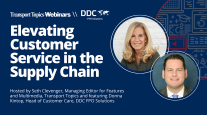Senior Reporter
Seroka Applauds Administration’s Investment in Supply Chain

[Stay on top of transportation news: Get TTNews in your inbox.]
Port of Los Angeles Executive Director Eugene Seroka says that as the Biden administration spends more than $18 billion on upgrading the nation’s ports as part of the Infrastructure Investment and Jobs Act, his facility and the neighboring Port of Long Beach — the nation’s largest, busiest facilities — and others are getting the money they need to remain competitive with global facilities that are also undergoing upgrades.
“Starting with the president’s executive order shortly after he took office on the supply chain and specific commodities and through today with Secretary [Pete] Buttigieg at the Department of Transportation, this administration has done more for our industry than I can recall in my many years in this business,” Seroka said March 12 in an exclusive interview with Transport Topics. “There is still much effort around the bipartisan infrastructure law and the Inflation Reduction Act.”
In addition to the federal money, the California ports are getting an additional $1.5 billion, including approximately $450 million for zero-emission infrastructure, locomotives, vessels and vehicles as part of the state’s effort to build a more efficient, sustainable and resilient supply chain.
Seroka said port leaders are also working with the U.S. Environmental Protection Agency, which will issue $3 billion in grants this year for port improvements.
“These grants will be of great importance to us when it comes to clean vehicles and infrastructure for ports throughout the country,” he said.
The EPA’s Clean Ports Program will award funding for zero-emission port equipment and infrastructure and for climate and air quality planning at ports.
The deadline to file for those grants is May 28. Those selected will be notified in September, and the money will be disbursed in December.
Seroka was in Washington, D.C., on a two-day trip, meeting with lawmakers and other leaders as part of a delegation of Los Angeles Area Chamber of Commerce members during its annual Access D.C. event.
“I always tell members of Congress that goods that come through the Port of Los Angeles every day are eventually delivered to all 435 congressional districts, so the port has an enormous impact on not only Southern California but the entire country,” Seroka emphasized.
The move to lower emissions at the Los Angeles and Long Beach ports comes as many in California are urging state and regional regulatory agencies to slow the rollout of rules designed to reduce emissions from ports, warehouses, trucking and railroads because of the enormous implementation costs. But Seroka said the Southern California ports are doing their part.
“The ports of Los Angeles and Long Beach are the only ones in the nation to have on paper specific milestone dates for zero-emission and zero-carbon operations,” he said, pointing to the Clean Air Action Plan, which was adopted in 2006 and later updated in 2017 as a road map to have the facilities at zero emissions by 2035. “The technology is still in its early days, and the equipment costs are much higher than those of contemporary vehicles, but the people living near the ports and along the routes to the Inland Empire and the warehouse and distribution centers deserve the cleanest possible air. We are working with the original equipment manufacturers, infrastructure experts, and local, state and federal officials to see how we can move this needle as best we can.”
Seroka and others have pointed out that since the plan was adopted, port-related air pollution emissions in San Pedro Bay — the gateway to both ports — have dropped 90% for diesel particulate matter, 63% for nitrogen oxides and 97% for sulfur oxides. In its 2017 update, greenhouse gases from port-related sources were included as part of the program.
“Folks here in Washington want to know what works and doesn’t,” he said. “The 7,500 acres of the Port of Los Angeles is a test lab for the manufacturers and the scientists for what works and what doesn’t.”
As the world marks the fourth anniversary of the COVID-19 pandemic this month, Seroka said the role ports play in keeping the economy moving is as important as ever.
Want more news? Listen to today's daily briefing above or go here for more info
“What we have taken away from COVID-19 is how vital the supply chain is to the American economy, the consumer and the health of this nation,” he said. “January business at the Port of Los Angeles was up 18%, and my projection for Q1 is that we will be up 20% year-over-year,” he said. “What I am hearing from importers and exporters alike is that because of concerns over security in the Red Sea and the drought conditions in Panama, we are starting to see a few more bookings come our way, and they would normally go through Suez or Panama canals.”
Seroka also said the ongoing attacks by Iranian-backed Houthi rebels in the Red Sea “aren’t going away and will continue.” Earlier this month, rebels killed three crew members and wounded several others during an assault on a Liberian-owned bulk carrier. “There are more conflicts in the Middle East, and the rebels have more technology and weapons. It’s going to impact shipping,” he said.
Executive Editor Joe Howard contributed to this report.




